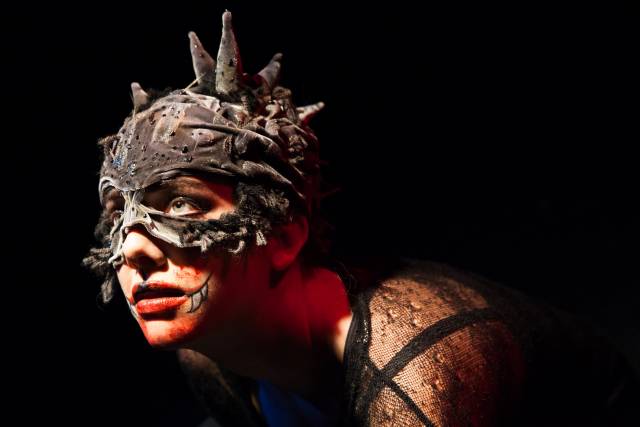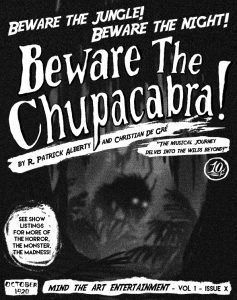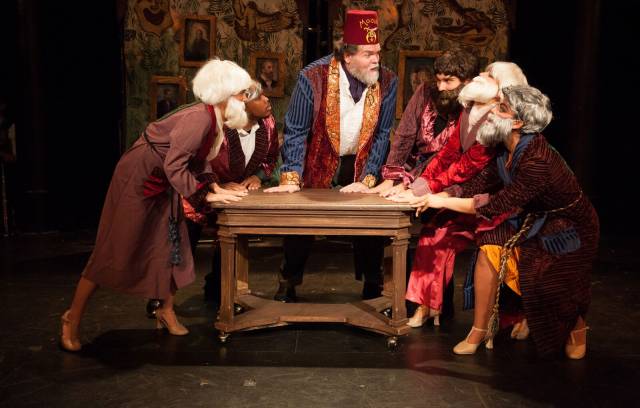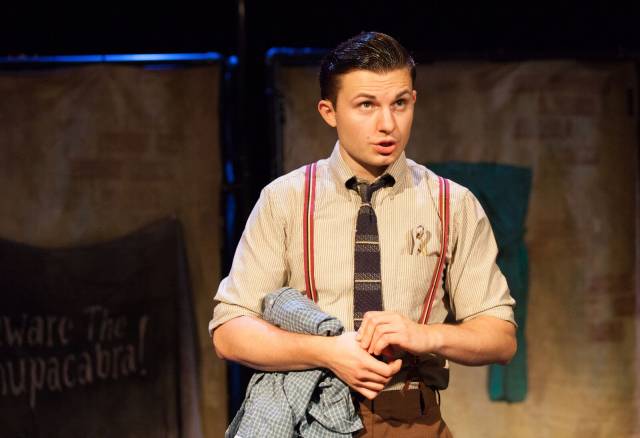
 We talked to the playwrights and composers behind the shows selected for Fringe Encores, here's Christian de Gré, the talented writer and co-director of Beware the Chupacabra! (our review).
We talked to the playwrights and composers behind the shows selected for Fringe Encores, here's Christian de Gré, the talented writer and co-director of Beware the Chupacabra! (our review).
Just how many times did you watch King Kong before and during writing the show?
I have actually never seen King Kong. As a Mexican kid growing up it wasn't a cultural staple for me like for most Americans. I suppose I will have to watch it now as this is my second show to get compared to it, (Fatty Fatty No Friends is the other.)
Fair enough, can you share with us some of your favorite classic monster movies from which the show borrows elements?
Patrick our book writer and lyricist is probably better at answering this in terms of classic movies, as he was a quite fixated on playing homage to the classics. For me I love Pan's Labyrinth as the absolute contemporary horror film (probably due to my Mexican bias again) but for this show I pulled a lot of my musical influences from Victorian opera, dark jazz from the early 1900's and Germanic folk tales. Also the novels Jekyll and Hyde and other Latin myths like "La Llorona" were huge influences for this show. It is also interesting to note that our illustrator in Mexico, Elias "Uva" Diaz, was playing with images of the blob and the creature from the black lagoon for the poster and Ashley Soliman our production designer was playing off of old horror comics from the 20's and 30's.
Ultimately this is what they landed on:
 Apologies for being so persistent with the classic Hollywood questions, but there are numbers, particularly involving Everett O'Neill's character and the hilarious gentlemen's society, which made me think of the Marx brothers, in that they don't add much to the plot, but are a treat to sit through. Can you talk about how you picked which numbers to include and which, if any, were removed?
Apologies for being so persistent with the classic Hollywood questions, but there are numbers, particularly involving Everett O'Neill's character and the hilarious gentlemen's society, which made me think of the Marx brothers, in that they don't add much to the plot, but are a treat to sit through. Can you talk about how you picked which numbers to include and which, if any, were removed?
I personally have a huge soft spot for the classic Disney villain and Patrick had a fascination with telling this class warfare story in a farcical way. I think he did a brilliant job at writing real historical characters like Harding, Armstrong and Hayes and then building this hilarious fictional foil around them. I think we were both so excited to see these fun old men evolve that we almost got too carried away in the first drafts of the piece. Arris Warner (the villain role) has probably had the most cuts and changes, he had a song called "I'ma Kill a Beast" and another Gilbert and Sullivan/Vaudeville recitative number describing all the way he wished for the lead to die. Ultimately we settled on LADS as the big production number where we have these far right-wing conservatives sing about their hate for socialism and their desire for hunting endangered animals. The irony to me is that these old white guys are played by a company of girls, a homosexual young guy and an African American, I guess it was a way to further infuriate the party we were describing. In the end Patrick and I have enjoyed writing this show so much that he personally will be jumping into the role of Arris Warner at Encores.
The show subverts elements of sexism and racism that were prevalent during the time in which it takes place. Is it easy for you to approach art made during this era and not cringe about certain things? What elements found in modern society do you think will make audiences cringe 70 years from now?
Personally I believe in telling the truth of the moment no matter what and having the courage to write it that way. The 20's were sexist and racist and the commercial art of that period and particularly its following decades was very closely tied to stereotypes that were rooted in cringe worthy bias. What I LOVE about Patrick's script is how he takes these head on and commits and then flips the expectation. I was adamant on having Robb Moreira have a part written into this show because I have worked with him before on other Mind The Art shows and he played different kinds of offensive stereotype roles there. One of my favorite moments in this show is when this Mexican cantina owner type shows up in a sombrero and you see the audience's eyes widen in horror thinking we are going to give you this horrible stereotype (which btw his name is "Tipo" for a reason) and then as the show evolves he is a fully fleshed out character, a voice of reason and part of the heart of the show. I feel the same way about how Chupacabra is written and how she represents both our attitudes toward women and nature at that time, but I won't spoil the ending by saying more on that. To answer the second part of your question, my work always has to be grounded in some social message to be worth working on. I used to work for the United Nations and did a lot of social political theater and that part of me never died. The last few shows I've worked on metaphorically address othering, school shootings, racism, bullying, feminism, social apathy, alcoholism and with Chupacabra, stereotype, class divides and our expectations around gender roles. 70 years from now I look forward to seeing how people think I was so backwards writing about things we have all hopefully accepted and have a socially conscious and empathetic eye.
 What do you think is the role of musical theatre in avoiding things that make people cringe in the future?
What do you think is the role of musical theatre in avoiding things that make people cringe in the future?
Let's start with aesthetics and then hit content. For me Musical Theater is going to die if we continue to gloss over story, purpose and form. I am beyond frustrated with the amount of new musicals that are concept driven but have no story and above that I am really tired of hearing shows with the same standard Off-Off-Broadway musical theater sound. There is a generic sound that I consistently hear from Musical Theater composers that all sound like a weaker version of Avenue Q mixed with Next to Normal and it drives me insane! This is leading our art form into becoming obvious and predictable. For me I am much more excited about writing a discordant piece in a non traditional time signature and orchestrating for a woodwind ensemble than in writing another pop musical with an electric guitar. Even it it fails, at least taking that risk and pulling from this huge wealth of other musical sounds is the only way we can evolve as an art form. Whether we are pulling from Opera and Jazz like Bernstein did; or Hip-Hop and Rap like Lin-Manuel is; or Electro Pop and Folk like Dave Malloy is; we need to, as young composers, all think outside the musical theater song standard and take some risks. To me, simple, predictable music is what makes people cringe about musical theater the most. After that it's about content and awareness, if your show is insulting or offending, I hope it's justified and that you are aware and that it serves a purpose, otherwise you are in for some trouble. In other words, I believe we need to take risks, be bold and above all, be aware of what we are saying and how we are saying it.
Elaborate on finding the right musical style for the show. Were you tempted on doing a rock musical for instance?
Ha! After my rant you can see why I chose not to go with a Rock score. I wanted to find the right sound for the time period and the story. For me that was pulling from Jazz and Operetta in New York with numbers like "Miss V" and "Bloodsuckers" for that Bernstein meets Gershwin meets Kurt Veil sound and then when we get to Mexico it was about pulling from old Mexican folks sounds for a song like "Chupacabra." Then there was her sound, I wanted something primal and discordant but pretty for her so I played with two keys simultaneously and her song "No Need for The Rain" plays on an G Minor chord on the right hand over and Fminor chord on the bass, that created a discomforting lullaby sound which I thought was the voice of a misunderstood monster. Of course as the show builds and we get the semblance of a love story feel we move more into a more traditional pop ballad to show how these two characters musically evolve into having a sound that is just comforting for them and a unique voice. The biggest challenge above all was orchestrating for these sounds with a festival band which has its limitations on how many instruments you can use and the dangers of live acoustics. Ultimately a woodwind ensemble and piano, as much as people rolled their eyes at me, was the choice I went with. The clarinets give you that operetta and folk song feel, and the sax hints at Jazz, and when we get to Mexico the flute gives you that lighter Spanish influence that reminds us of Latin America (and of course a Mariachi singer always helps too.) The singers of course, under Aaron Butler's incredibly tenacious direction, are the true masters at work. We have a cast of Jazz singers, Crooners, Opera singers, Musical Theater belters and even a Heavy Metal singer, it's these guys who really give us the feel for each style of music and help bring forth the ideas.
Can you share the qualities you were looking when you were casting the Chupacabras character? Also comment on finding the look of the creature.
We wanted someone who had vulnerability, strength, beauty and a unique voice. We were blessed to find Charly. Her physical movement work in this is exquisite and she has a voice capable of many different sounds and timbres. She plays the role with a perfect mix of beast and beauty and it's her grace and bravery that makes this such a rewarding character. Her look was brought to life by the amazing Ashley Soliman who is my visuals soulmate. She wanted to stay true to the classic horror look and add a beauty and sexiness to the character as well. I think she found the perfect balance of beauty and the beast all rolled into one while staying true to the look of classic horror movies.
 A lot of the show's weight falls on Vinnie Urdea, whose character might not be the sharpest tool in the shed, but who has an undeniably adorable quality. How do you write and cast a hero who is so clumsy? Were you worried that people wouldn't root for him?
A lot of the show's weight falls on Vinnie Urdea, whose character might not be the sharpest tool in the shed, but who has an undeniably adorable quality. How do you write and cast a hero who is so clumsy? Were you worried that people wouldn't root for him?
We all fell in love with Teddy Baskins when we first saw Patrick's script and for me once the song "Patterns" was written I really knew who this guy was. I think for all the many male leads that are written no-one really nails the shy hero who struggles with his own masculinity in a genuine way. Vinnie and I had worked together before, he was our villainous bully rapper in Fatty Fatty No Friends, and I knew he had the vocal mastery to play a fast talking and patter sounding character who just runs his mouth off when he's nervous. It was fun to put Vinnie in an opposite role from what he did with us before and yes he's just so damn lovable and it's his honesty that sells the character.
The ensemble players are a true joy! Is it safe to assume that theirs were the most fun songs to write?
When we cast the show I had to really sell the concept to these guys. They play such a range of characters from Mariachis, to the homeless, to rich Jersey girls, old white men, servants, Mexican peasants and even a painting of Teddy Roosevelt. We needed these guys to be flexible and capable of switching characters at the drop of a hat. For me that meant casting racially and vocally diverse actor/singers who above all wanted to have fun and take some risks.They are amazing to work with and it's so fun to write for such a range of voices and types.
How did you divide duties with R. Patrick Alberty?
Patrick and I have worked together for many years and at this point it's hard to tell where one of us starts and the other ends. But if you MUST know, Patrick wrote the book and lyrics and directed the actors in the book scenes, I wrote the music, worked with the designers and blocked the musical numbers with our lovely choreographer Mariel Lowe. Then he and I shared producing duties with our amazing and tireless lead producer Serrana Gay.
Will the show undergo any changes before Encores?
Yes, we have tightened the show a lot. We needed to get to the Mexico part of the story faster and we have made cuts to reflect that. We also streamlined the arc for Teddy and lessened the number of secondary roles. Finally the biggest change is Patrick going into the role Warner, which is very different and truly delicious to watch.
Where does the show go next?
We are currently negotiating a development contract for next season but I can't say more or I will jinx it. Meanwhile you can catch our other two shows (many who share cast members from Chupacabra) this Fall at the C.O.W. (Fatty Fatty No Friends) and Drom (Whiskey Pants: The Mayor of Williamsburg)
For tickets and dates visit the Fringe Encores website. Use promo code FESCUB to receive a $5 discount on your tickets by clicking here.